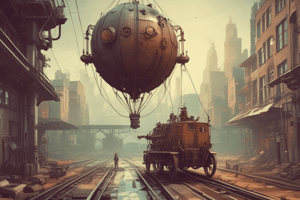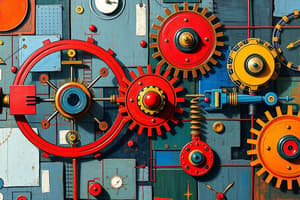Podcast
Questions and Answers
How much force is required to lift the weight?
How much force is required to lift the weight?
60 lbs
Which weight requires the least force to move?
Which weight requires the least force to move?
- A
- B (correct)
- Both require the same force
What will be the total distance that the springs in parallel are compressed?
What will be the total distance that the springs in parallel are compressed?
5 cms
How many switches need to be closed to light up one bulb?
How many switches need to be closed to light up one bulb?
How many bulbs will light up when the switch is closed?
How many bulbs will light up when the switch is closed?
If bulb 1 is removed, how many bulbs will light up when the switch is closed?
If bulb 1 is removed, how many bulbs will light up when the switch is closed?
How much weight is required to balance the lever?
How much weight is required to balance the lever?
How far from the fulcrum does the 60 lb weight need to be to balance the lever?
How far from the fulcrum does the 60 lb weight need to be to balance the lever?
Approximately how much force is needed to lift the weight?
Approximately how much force is needed to lift the weight?
If gear X turns clockwise at a constant speed of 10 rpm. How does gear Y turn?
If gear X turns clockwise at a constant speed of 10 rpm. How does gear Y turn?
If bar Y moves left at a constant speed. How does bar X move?
If bar Y moves left at a constant speed. How does bar X move?
If drive wheel X rotates clockwise at a speed of 10 rpm. How does wheel Y turn?
If drive wheel X rotates clockwise at a speed of 10 rpm. How does wheel Y turn?
How much force is required to compress three springs in parallel 10cm?
How much force is required to compress three springs in parallel 10cm?
What is the approximate area of the component in square centimetres?
What is the approximate area of the component in square centimetres?
What is the approximate percentage of steel wasted?
What is the approximate percentage of steel wasted?
How many components can be produced from each 30 meter coil?
How many components can be produced from each 30 meter coil?
What is the approximate cost of a component if the scrap is sold at 50% of cost?
What is the approximate cost of a component if the scrap is sold at 50% of cost?
How far does B need to move to lift the weight 6 feet?
How far does B need to move to lift the weight 6 feet?
Which of the pulley systems shown are stable?
Which of the pulley systems shown are stable?
What will be the total distance that the springs in series are compressed?
What will be the total distance that the springs in series are compressed?
How many bulbs will light when switches 1, 2, 3 and 4 are closed?
How many bulbs will light when switches 1, 2, 3 and 4 are closed?
What is the approximate total volume of the component in cubic centimetres?
What is the approximate total volume of the component in cubic centimetres?
What is the approximate weight of the component?
What is the approximate weight of the component?
Which figure is identical to the first?
Which figure is identical to the first?
Which group of shapes can be assembled to make the shape shown?
Which group of shapes can be assembled to make the shape shown?
Which shape can be assembled using all of the individual shapes shown?
Which shape can be assembled using all of the individual shapes shown?
Which pattern can be folded to make the cube shown?
Which pattern can be folded to make the cube shown?
Flashcards
Lever
Lever
A bar that pivots around a fixed point (fulcrum) to help lift or move objects.
Fulcrum
Fulcrum
The fixed point around which a lever pivots.
Distance from fulcrum to weight (d1)
Distance from fulcrum to weight (d1)
The distance from the fulcrum to the weight being lifted or moved.
Distance from fulcrum to force (d2)
Distance from fulcrum to force (d2)
Signup and view all the flashcards
Force (f)
Force (f)
Signup and view all the flashcards
Weight (w)
Weight (w)
Signup and view all the flashcards
Pulley
Pulley
Signup and view all the flashcards
Fixed Pulley
Fixed Pulley
Signup and view all the flashcards
Movable Pulley
Movable Pulley
Signup and view all the flashcards
Single Pulley
Single Pulley
Signup and view all the flashcards
Double Pulley
Double Pulley
Signup and view all the flashcards
Gear
Gear
Signup and view all the flashcards
Gears with chain or belt
Gears with chain or belt
Signup and view all the flashcards
Meshed Gears
Meshed Gears
Signup and view all the flashcards
Odd number of meshed gears
Odd number of meshed gears
Signup and view all the flashcards
Gears with equal teeth
Gears with equal teeth
Signup and view all the flashcards
Gears with unequal teeth
Gears with unequal teeth
Signup and view all the flashcards
Spring
Spring
Signup and view all the flashcards
Linear Spring
Linear Spring
Signup and view all the flashcards
Springs in Series
Springs in Series
Signup and view all the flashcards
Springs in Parallel
Springs in Parallel
Signup and view all the flashcards
Electricity
Electricity
Signup and view all the flashcards
Switch
Switch
Signup and view all the flashcards
Load
Load
Signup and view all the flashcards
Wiring
Wiring
Signup and view all the flashcards
Closed Circuit
Closed Circuit
Signup and view all the flashcards
Open Circuit
Open Circuit
Signup and view all the flashcards
Study Notes
Levers
- A lever is a bar that pivots at a fixed point called the fulcrum.
- Levers can be used to reduce the force needed to move an object.
- The force needed to lift a weight on a lever is calculated using the formula: Force = (Weight x Distance from fulcrum to weight) / Distance from fulcrum to point where force is applied.
- If the fulcrum is moved closer to the weight, less force is required to lift it.
Pulleys
- Pulleys consist of a grooved wheel and a block.
- A rope runs in the groove around the wheel to lift a weight or other object.
- A fixed pulley requires a force equal to the weight to lift it.
- A pulley that moves with the weight requires a force equal to half the weight to be lifted.
- Pulleys reduce the force required to lift a weight.
Gears
- Gears are toothed wheels or cylinders that mesh with another toothed component to transmit motion or to change speed or direction.
- Gears can be connected directly or by a chain or belt.
- Adjacent gears turning in the same direction, turn in opposite directions.
- When the gears are connected to the same shaft and turn in the same direction, they are turning in the same direction as each other.
Springs
- A spring is a piece of wire or metal that stretches or compresses when a force is applied but returns to its original length when the force is removed.
- Springs behave linearly; doubling the force applied will stretch or compress the spring twice as much.
- Springs can be arranged in series or in parallel
- Series: The force in each spring is equal; parallel springs each spring share an equal amount of the force.
Electricity
- Questions on electricity often use diagrams showing the power source, switches, loads (like bulbs), and wires.
- For circuits to work, the path of the wiring needs to be complete.
- Two switches have to be closed to complete a circuit correctly.
Mechanical IQ
- Multiple questions on levers, pulleys, gears and springs are presented.
- Various formulas for levers, pulleys, and springs are needed to solve the questions.
- The student needs to show understanding of concepts to calculate answers.
Studying That Suits You
Use AI to generate personalized quizzes and flashcards to suit your learning preferences.
Related Documents
Description
Explore the fundamental concepts of levers, pulleys, and gears in this quiz. Learn how these simple machines can reduce the effort needed to perform tasks by understanding their mechanics and formulas. Test your knowledge on their functions and applications in everyday life.




